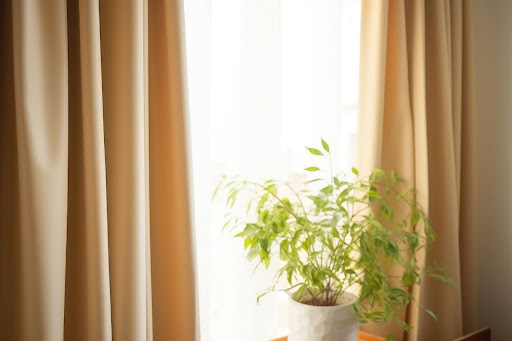
We’re here to provide a comprehensive overview of window insulation, highlighting its crucial role in optimizing home comfort and energy performance. We aim to cover the science of heat transfer through windows, explore diverse insulation techniques, and analyze their effectiveness in achieving thermal control and cost savings.
Why prioritize window insulation
Investing in proper window insulation offers multitude of benefits:
- Enhanced thermal comfort: During both summers and winters, adequate window insulation effectively minimizes heat transfer to help maintain consistent and comfortable indoor temperatures.
- Reduced energy consumption: By mitigating heat loss and gain, well-insulated windows lessen the reliance on HVAC systems and lead to significant energy cost savings.
- Environmental impact: Lower energy consumption translates to reduced greenhouse gas emissions, which contributes to a more sustainable future.
- Noise reduction: Certain insulation methods, such as double glazing, offer the added benefit of dampening external noise pollution. This promotes a more peaceful indoor environment.
Heat transfer through windows occurs through two main avenues: conduction, where warmth simply leaks through the glass itself, and air leakage, where sneaky drafts infiltrate through cracks and gaps around the frame.
These culprits disrupt the comfortable thermal equilibrium within your home and can leave you shivering and facing higher energy bills to compensate.
Addressing these heat escape routes is therefore crucial for achieving that blissful indoor haven we all crave.
A range of insulation solutions cater to different budget and performance requirements. We’ll cover more about each of these later on.
Caulking and weatherstripping are readily available, low-cost options that effectively seal air leaks around window frames. Transparent or reflective films applied to existing windows enhance thermal resistance and offer solar heat gain control. Installing windows with two or three glass panes separated by an insulating gas gap dramatically reduces heat transfer and improves energy efficiency.
Emerging technologies such as smart glass, which dynamically adjusts its properties based on environmental conditions, present promising avenues for future advancements in window insulation.
Implementing effective window insulation strategies delivers tangible benefits for homeowners, from increased comfort and cost savings to reduced environmental impact. By understanding the principles of heat transfer and exploring the available insulation options, you optimize your home’s thermal performance and create a more sustainable and comfortable living space.
A closer look at window insulation
Embarking on a journey to enhance the comfort and efficiency of your home starts with a solid understanding of window insulation. Here, we’ll unfold what window insulation means, examine the pivotal role windows play in maintaining your home’s climate, and dissect how various window designs influence insulation effectiveness.
At its core, window insulation creates a barrier that reduces the unwanted exchange of heat through your windows. This means keeping warm air inside during the chilly months and preventing heat from infiltrating during the hotter days.
But how does it achieve this?
Window insulations prevent heat transfer through a variety of methods, ranging from the type of glass in your windows to additional enhancements like coatings and special gases trapped between panes. Proper insulation stabilizes your indoor temperature and cuts down on energy consumption and costs. Using proper window insulation is a smart, eco-friendly choice for any homeowner.
Traditional single-pane windows offer minimal insulation and are often culprits of energy loss. Upgrade to double-pane windows, and you’ll notice a significant improvement, thanks to the insulating air or gas layer sandwiched between the glass. Triple-pane windows elevate this further, making them ideal for frigid climates.
Features like low-E coatings, which reflect infrared light, and sturdy, thermally broken frames contribute to a window’s insulating abilities. Whether you’re looking at upgrades or seeking to maximize the potential of your current windows, understanding the mechanics of insulation and the impact of various window types is a step toward a warmer, more energy-efficient home.
Caulking and weatherstripping
While they may not be the most glamorous part of home maintenance, caulking and weatherstripping are essential for a tightly sealed home. Caulking fills in those sneaky cracks and gaps where air likes to escape, which makes a big difference in your home’s overall warmth and energy efficiency.
Weatherstripping, on the other hand, ensures that the moving parts of your windows don’t let drafts sneak in. Together, they work tirelessly to keep your home cozy, cut down on your energy bills, and even reduce outside noise.
Applying caulk and weatherstrip might sound like a chore, but with a little know-how, it’s a breeze. Begin by removing any old material and cleaning the area thoroughly. When choosing caulk, opt for one that’s compatible with your window material and designed to withstand your local weather. Apply it in a smooth, continuous line, ensuring every nook and cranny is filled.
For weatherstripping, measure twice and cut once to ensure a perfect fit. Stick it down firmly and pay extra attention to areas that see a lot of action. Patience and precision here mean a warmer, snugger home.

Like any other part of your home, your caulking and weatherstripping need a little TLC to keep them doing their job. Regularly inspect them for signs of wear, such as cracking, peeling, or gaps. Harsh weather, temperature fluctuations, and plain old time take their toll, so be prepared to touch up or replace parts as needed.
Window film insulation
Window film is a thin, almost invisible layer that regulates your home’s temperature by controlling the heat that passes through your windows. Many films offer UV protection, which helps reduce the fading of furniture and flooring caused by sun exposure. It also cuts down glare for added comfort.
There are a variety of window films tailored to different priorities. Each type brings its own set of advantages, from slashing energy bills to enhancing the comfort and protection of your interiors.
Low-E films are fantastic for retaining indoor heat in colder months. Solar control films excel in blocking out the sun’s heat and harmful rays, making them a boon in warmer climates or for rooms that get a lot of sun. Decorative films add style and privacy while still offering insulation benefits.
The installation dilemma
When it’s time to install window films, you’re faced with a choice. If you’re a hands-on person, a DIY installation might appeal to you. It’s more budget-friendly, and there’s a sense of satisfaction in doing it yourself.
However, it requires precision — any mistakes like air bubbles or misalignment hinder the film’s performance and aesthetics.
If you’re looking for flawless results and advice on the best film for your needs, professional installation is the way to go. Experts ensure a perfect fit, often back their work with a warranty, and save you the hassle and potential mishaps of a DIY project.
Thermal curtains and drapes
There are some unique insulating properties these window treatments offer. We will guide you through choosing the best match for your home and provide practical advice for using thermal curtains and drapes to effectively regulate indoor temperatures.
Thermal curtains are engineered to provide an additional layer of insulation. Crafted with special fabrics and often lined with a reflective thermal layer, these curtains work to create a barrier against heat loss.

Picking the right thermal curtains requires understanding your space and needs. Consider the direction your windows face, the local climate, and your home’s aesthetic. Heavier fabrics with dense weaves and a reflective backing are typically more effective at insulation. For the best insulation, curtains should extend well beyond the window frame and ideally reach the floor.
In order to leverage the full potential of your thermal curtains, you have to use them strategically. During colder months, let them open during the day on windows that receive direct sunlight to harness natural warmth, then close them as the temperature drops to trap the heat inside. In hot weather, keep them closed during the day to block out the sun’s heat, especially for windows facing direct sunlight.
Double glazing and window replacement
Double-glazed windows stand as a beacon of modern insulation technology, featuring two panes of glass with an insulating gap between them. This design curtails heat transfer and keeps your home snug in winter and cool during summer months. The result is a delightful indoor climate, coupled with a noticeable decrease in energy consumption and costs.
But the perks extend beyond temperature control; double-glazed windows also offer enhanced noise reduction that creates a serene and quiet indoor oasis. The robust construction of these windows further amplifies your home’s security by adding an extra layer of protection and peace of mind.
The decision to replace old windows with double-glazed alternatives requires careful consideration. Start by evaluating the performance and condition of your current windows.
Well-insulated, double-glazed windows enhance the overall value of your property. This means your upgrade is a comfort-enhancing and financially savvy decision.
Storm windows and panels
Storm windows and panels add an extra layer of insulation and protection against the elements over existing windows. They create an air pocket that reduces heat flow and keeps your home warm in winter and cool in summer. This is especially beneficial for homes with older windows. These additions also dampen external noise and increase security.
The installation of storm windows and panels depends on your home’s specific needs and the climate. Both external and internal options require precise measurements and secure fitting.
External storm windows provide robust protection and are ideal for older homes, but they alter your home’s exterior look and need a more involved installation. Internal options offer easier installation and removal, which makes them suitable for seasonal use and for preserving the home’s exterior aesthetics.
No matter your choice, storm windows and panels are a wise investment for a more insulated, comfortable, and energy-efficient home. Understanding their benefits, installation needs, and different types will help you make an informed decision that enhances your entire living environment.
Window frame insulation
The battle against drafts and energy loss is often fought at the windows, but it’s the frames that hold the line. When they’re compromised, drafts sneak in, and your hard-earned warm or cool air escapes. Ensuring these frames are airtight is important to maintain your desired indoor temperature and reduce the strain on your heating and cooling systems.
Keeping a vigilant eye on your window frames prevents minor issues from ballooning into major problems. Routine checks might reveal early warning signs like gaps you are able to feel with your hand, peeling or cracked caulking, or weatherstripping that’s seen better days.
If your cozy room suddenly feels drafty, or if there’s condensation where there shouldn’t be, these could be clues pointing to a breach in your window’s armor. While you can tackle many insulation issues with a trip to the hardware store and a little DIY spirit, don’t hesitate to call in the professionals for more complex situations.

Valley Glass — your trusted window insulation experts
Whether it’s upgrading your windows, tackling repairs, or seeking tailored advice, Valley Glass offers the expertise and attention to detail your home deserves. Our commitment to excellence means you get personalized solutions that truly make a difference in your living space.
So, when you’re ready to take the next step in enhancing your home’s energy efficiency and comfort, reach out to Valley Glass. Let us help you turn your home into the sanctuary of warmth and efficiency you’ve always wanted.


Leave a Reply